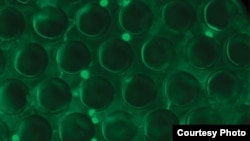A new device intends to make diagnosing AIDS easier and more accessible for people in developing countries.
The instrument would eliminate the need for expensive equipment and highly trained staff, resources that are not available in many areas where the HIV epidemic is most severe.
HIV kills by destroying a particular type of disease-fighting white blood cells called CD4+ T lymphocytes. Full-blown AIDS sets in when patients’ CD4 counts fall below a critical level and they are unable to fight off infections. That’s when antiretroviral drugs are critical.
But counting CD4 cells requires a blood sample and a lab equipped to analyze it. In many areas hardest hit by the AIDS epidemic - much of sub-Saharan Africa, for example, “there is just no way to get the patient or the blood very easily to the lab,” said Rashid Bashir, head of the bioengineering department at the University of Illinois at Urbana-Champaign.
Lab on a chip
So, Bashir and colleagues have developed a prototype “lab on a chip” with all the equipment and chemicals to do the job in a 3-centimeter-by-4-centimeter cartridge.
Bashir has a stake in Daktari Diagnostics, Inc., which is working to commercialize the chip and develop a hand-held, battery-powered reader.
“The promise is to bring the lab to the patient rather than the patient to the lab,” he said.
The device uses just a drop of blood. It separates the oxygen-carrying red cells from the disease-fighting white cells. It then isolates and counts the CD4 lymphocytes among those white cells.
Simple sample prep
Lehigh University bioengineering professor Xuanhong Cheng is not involved in the research, but she said combining processing and detection in one chip is an advantage over other CD4 counters in development.
“A lot of people just look at the detection side,” she said. “But if the sample has to be processed using very complicated methods, then it’s still not quite applicable in resource-limited settings.”
Bashir also sees applications for blood tests for infections or assessing a patient’s immune status prior to chemotherapy.
“Essentially, any application where blood cell counts are done, our goal is to turn that into a cartridge and a point-of-care device,” he added.
It will be at least a few years before any of them hit the market. Cheng also is working on developing a prototype CD4 counter into a product, and she noted, “The way that we make a device in a lab is very different from industrial manufacturing processes. So, the process is not as straightforward as some people would think.”
The need for these tools is urgent, though, and she said she’s glad for the competition.
“Definitely we need more people working on the area of global health diagnostics. I think we definitely need more new technologies,” said Cheng.
The instrument would eliminate the need for expensive equipment and highly trained staff, resources that are not available in many areas where the HIV epidemic is most severe.
HIV kills by destroying a particular type of disease-fighting white blood cells called CD4+ T lymphocytes. Full-blown AIDS sets in when patients’ CD4 counts fall below a critical level and they are unable to fight off infections. That’s when antiretroviral drugs are critical.
But counting CD4 cells requires a blood sample and a lab equipped to analyze it. In many areas hardest hit by the AIDS epidemic - much of sub-Saharan Africa, for example, “there is just no way to get the patient or the blood very easily to the lab,” said Rashid Bashir, head of the bioengineering department at the University of Illinois at Urbana-Champaign.
Lab on a chip
So, Bashir and colleagues have developed a prototype “lab on a chip” with all the equipment and chemicals to do the job in a 3-centimeter-by-4-centimeter cartridge.
Bashir has a stake in Daktari Diagnostics, Inc., which is working to commercialize the chip and develop a hand-held, battery-powered reader.
“The promise is to bring the lab to the patient rather than the patient to the lab,” he said.
The device uses just a drop of blood. It separates the oxygen-carrying red cells from the disease-fighting white cells. It then isolates and counts the CD4 lymphocytes among those white cells.
Simple sample prep
Lehigh University bioengineering professor Xuanhong Cheng is not involved in the research, but she said combining processing and detection in one chip is an advantage over other CD4 counters in development.
“A lot of people just look at the detection side,” she said. “But if the sample has to be processed using very complicated methods, then it’s still not quite applicable in resource-limited settings.”
Bashir also sees applications for blood tests for infections or assessing a patient’s immune status prior to chemotherapy.
“Essentially, any application where blood cell counts are done, our goal is to turn that into a cartridge and a point-of-care device,” he added.
It will be at least a few years before any of them hit the market. Cheng also is working on developing a prototype CD4 counter into a product, and she noted, “The way that we make a device in a lab is very different from industrial manufacturing processes. So, the process is not as straightforward as some people would think.”
The need for these tools is urgent, though, and she said she’s glad for the competition.
“Definitely we need more people working on the area of global health diagnostics. I think we definitely need more new technologies,” said Cheng.







